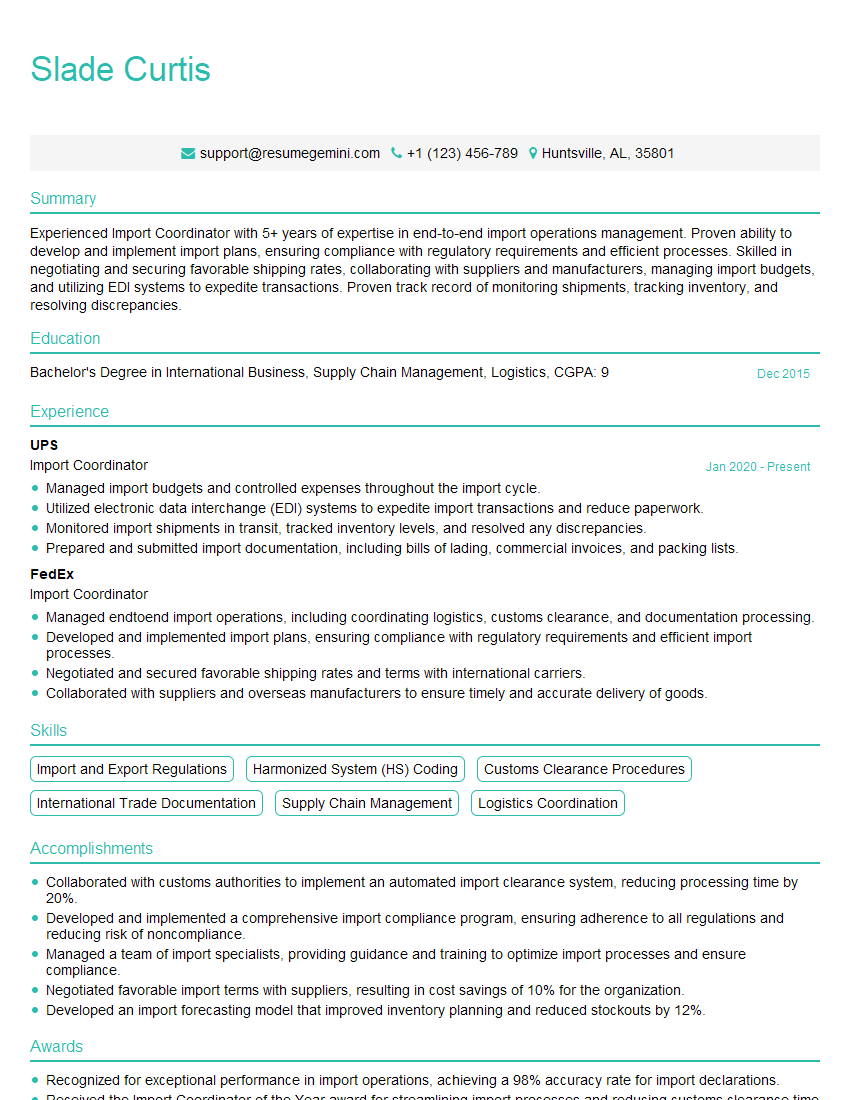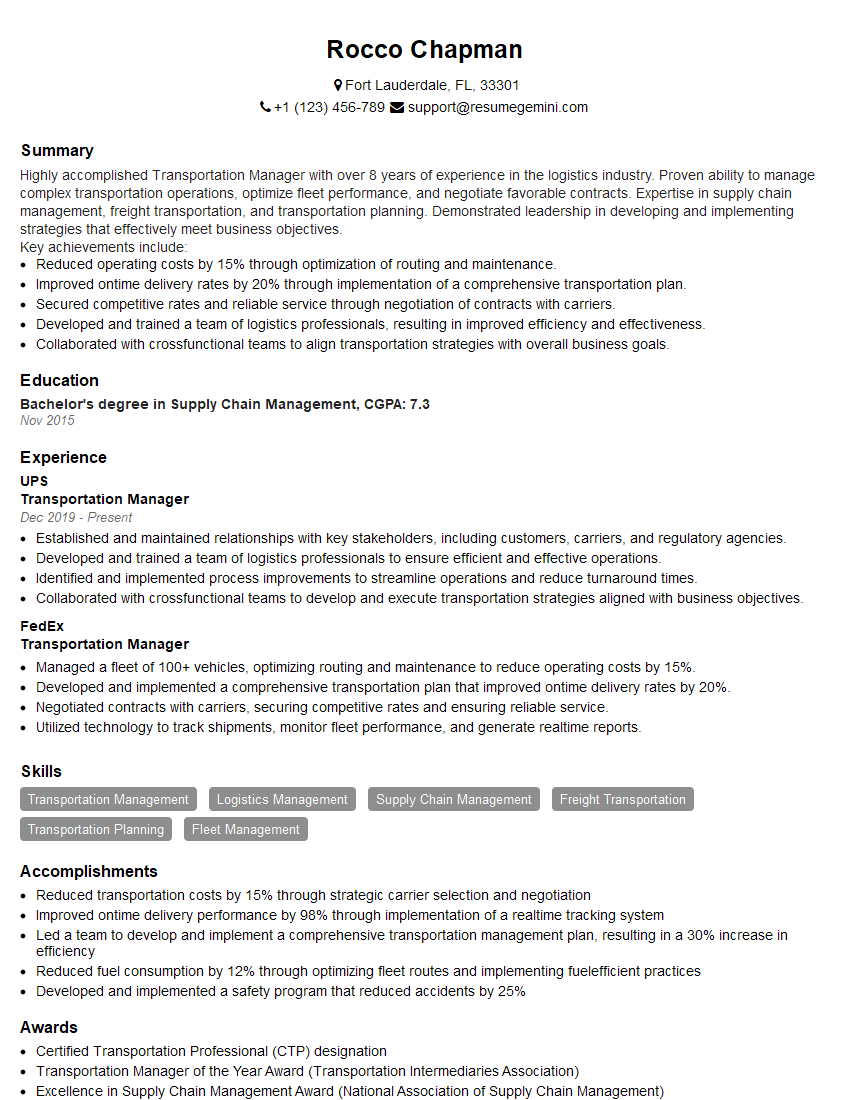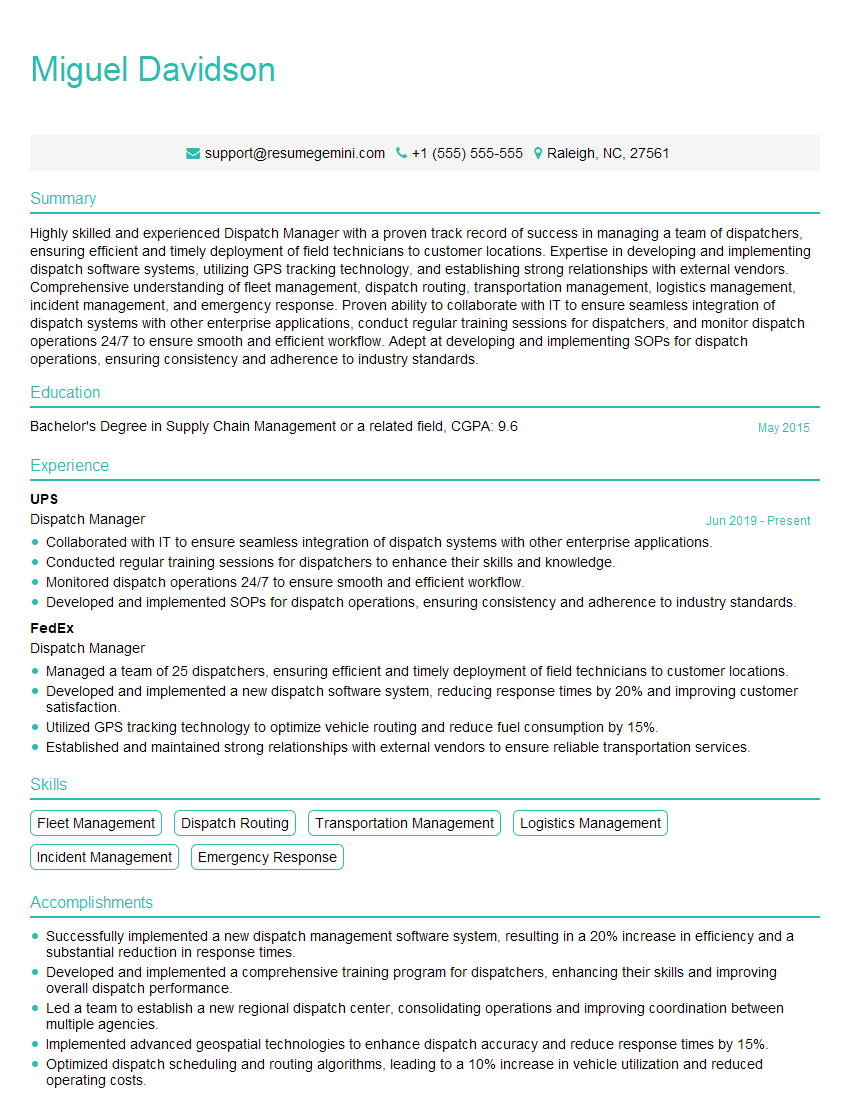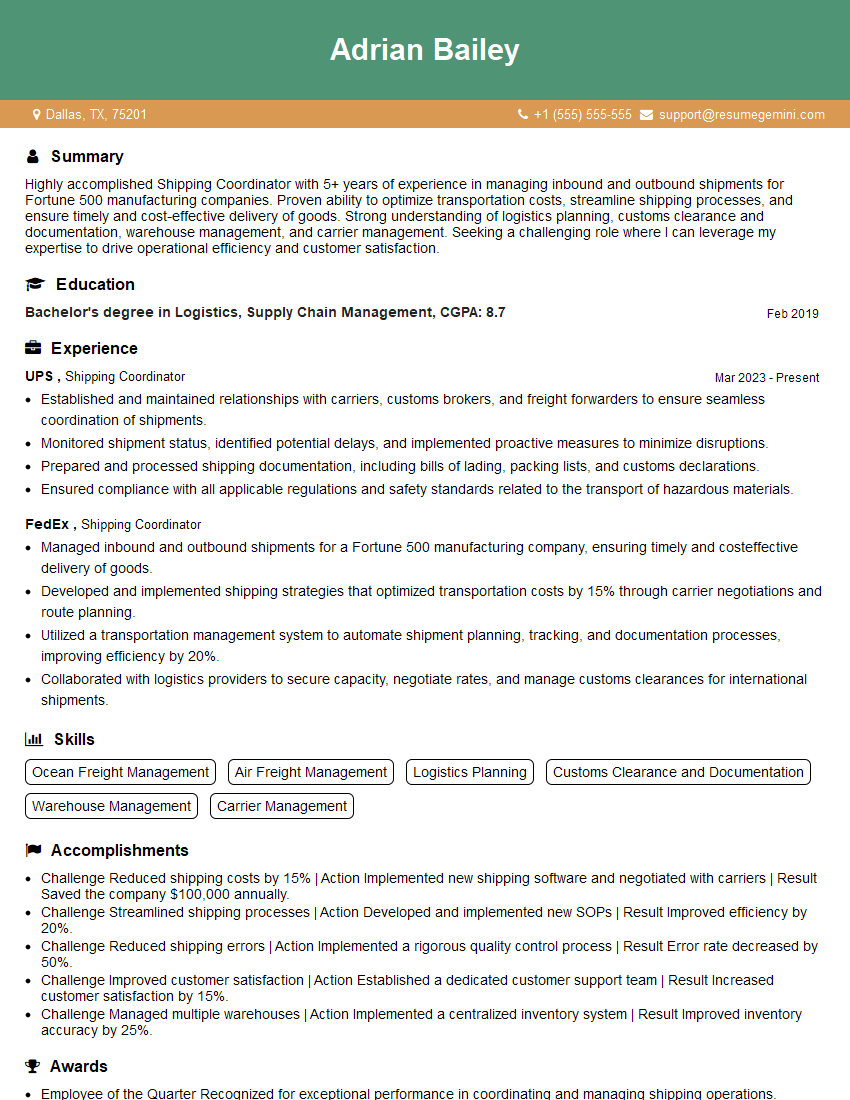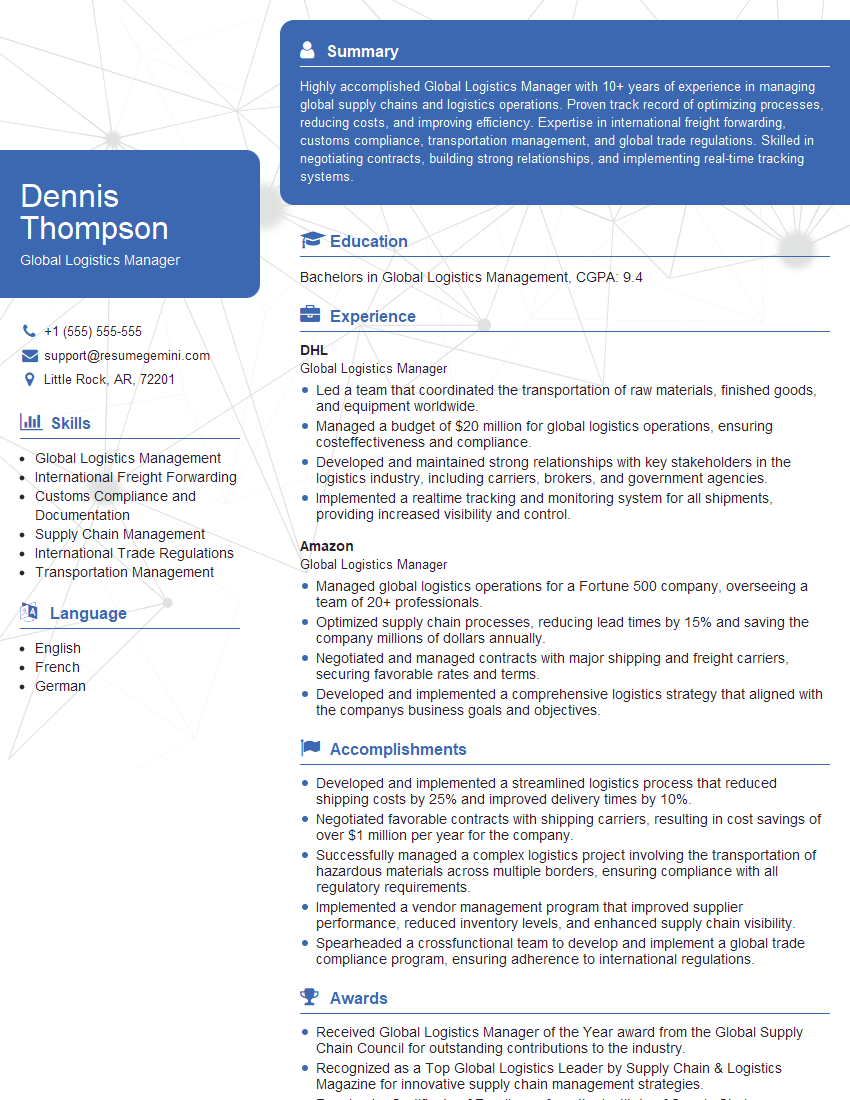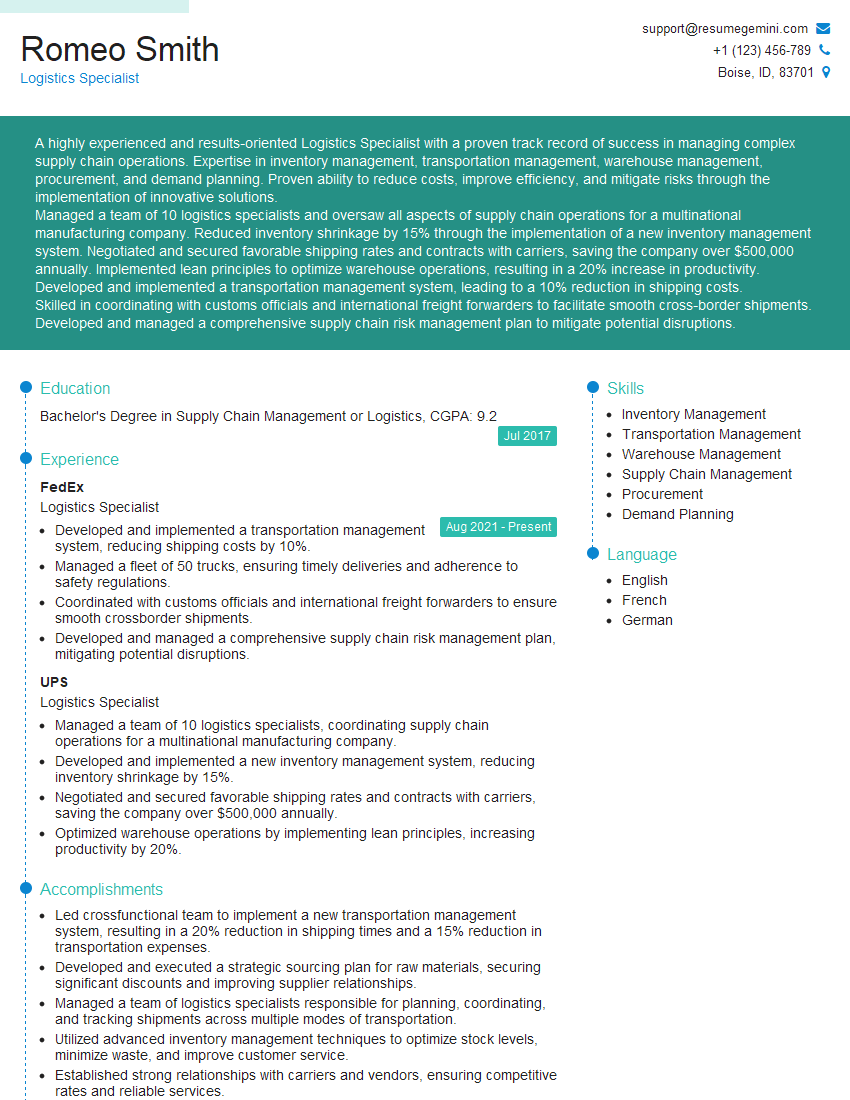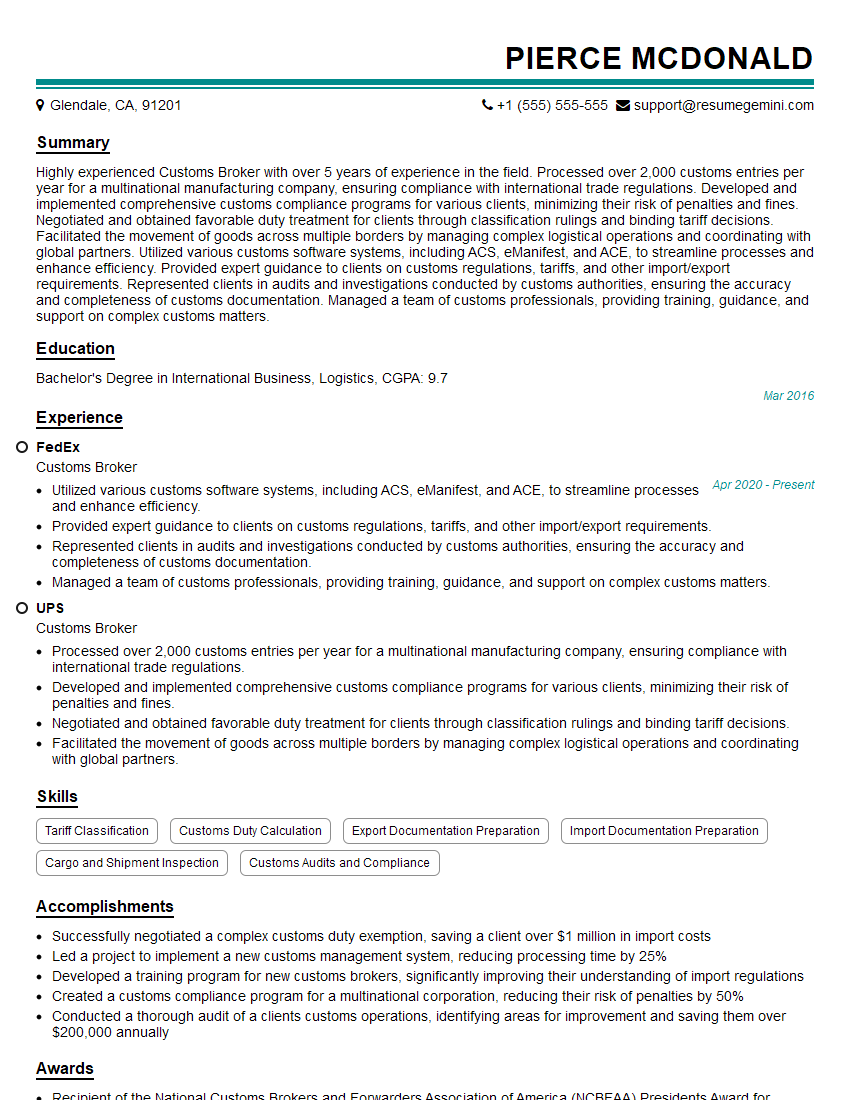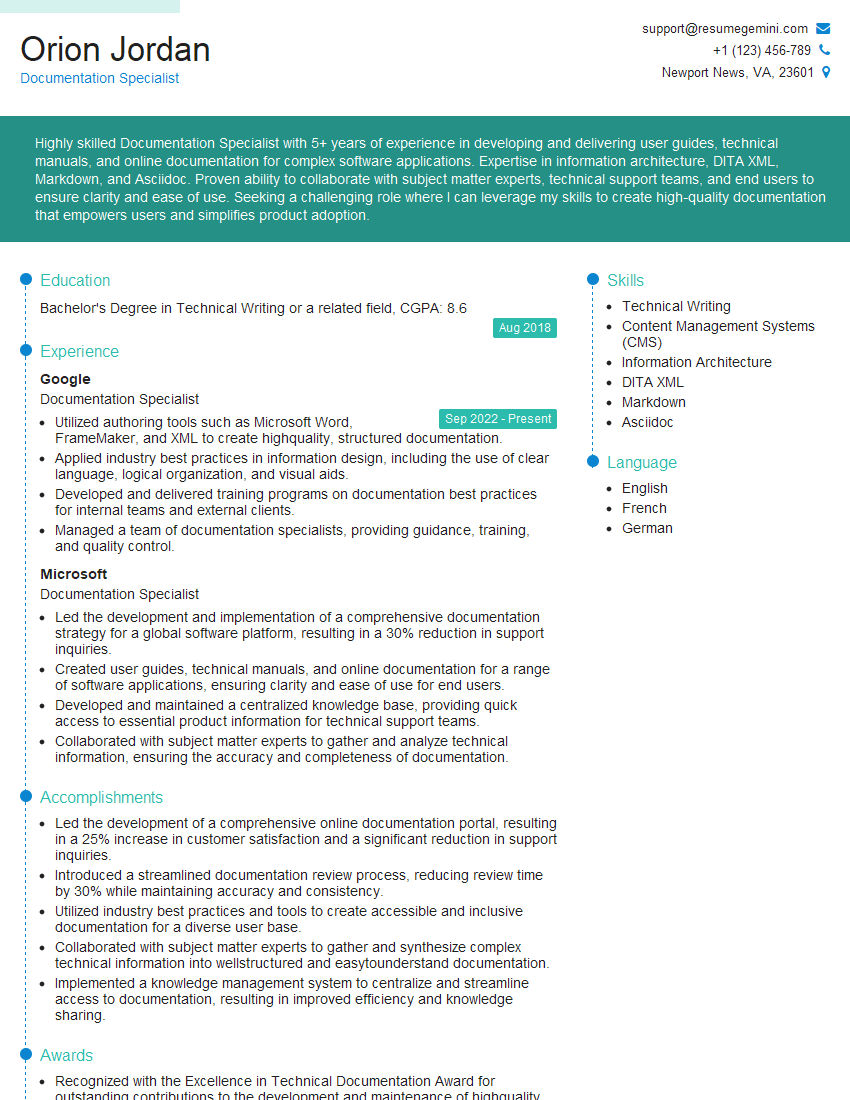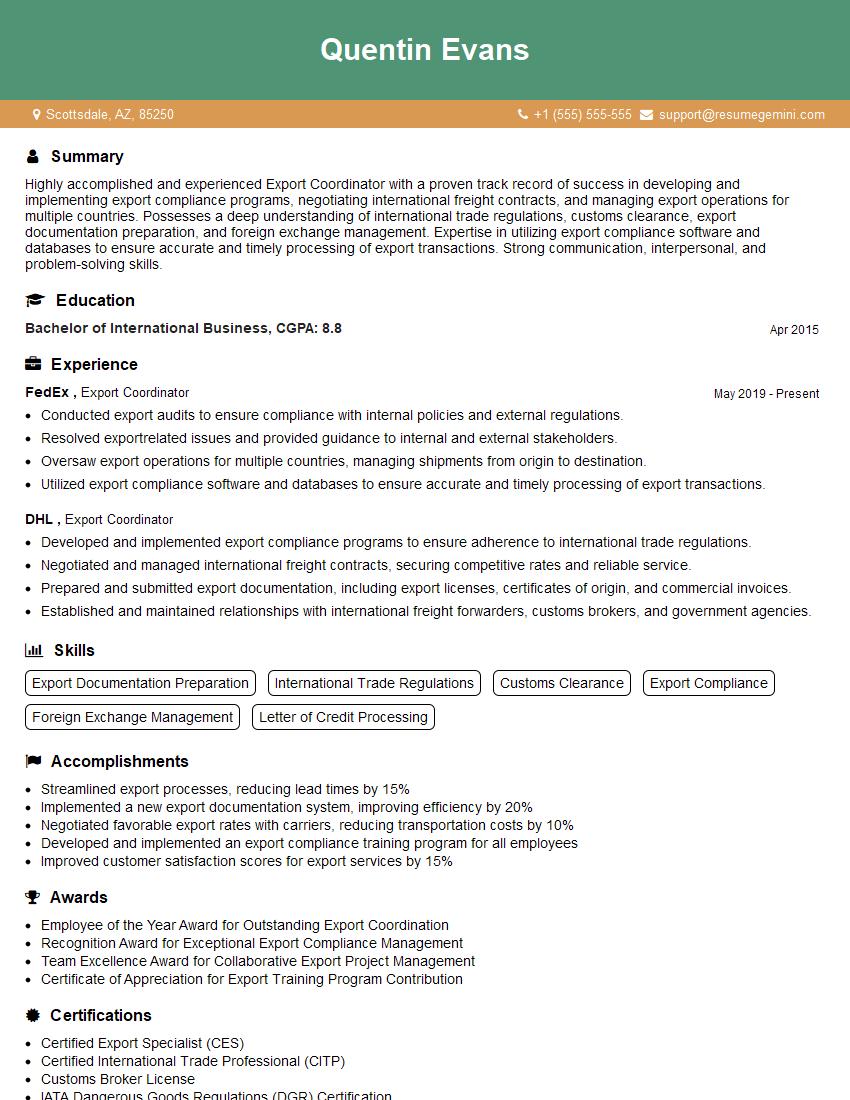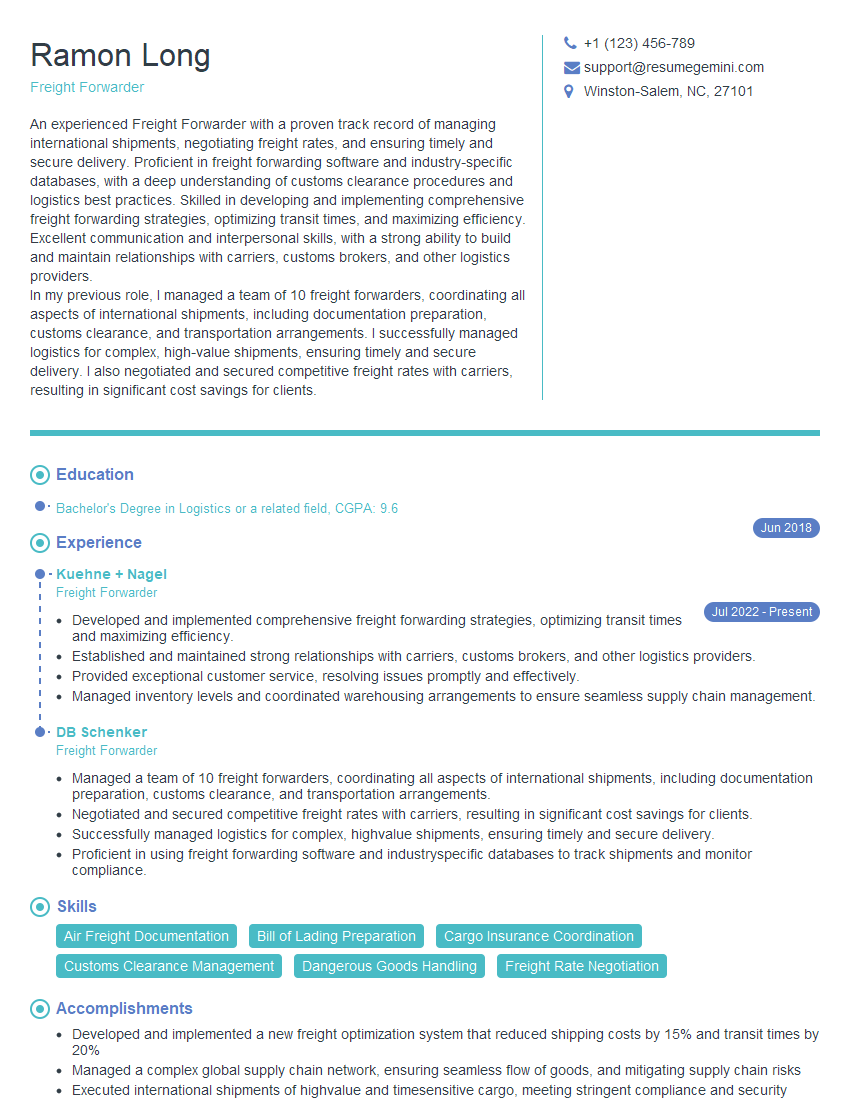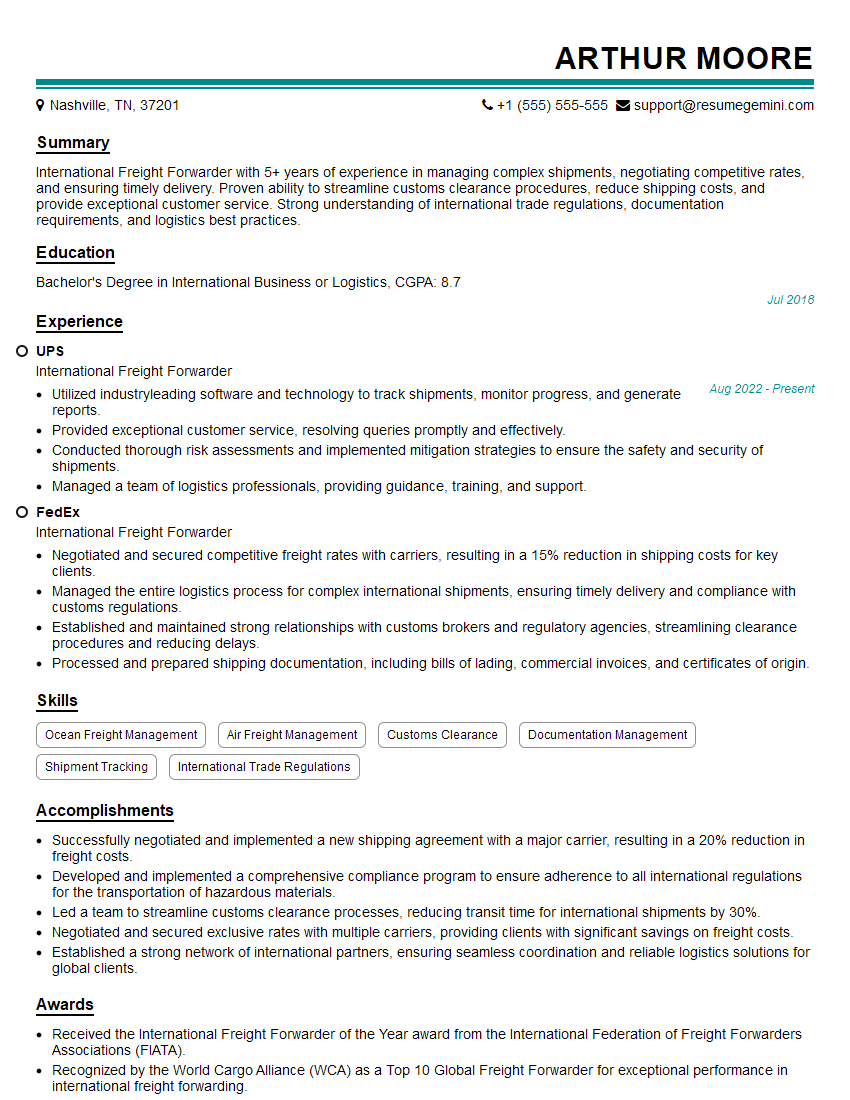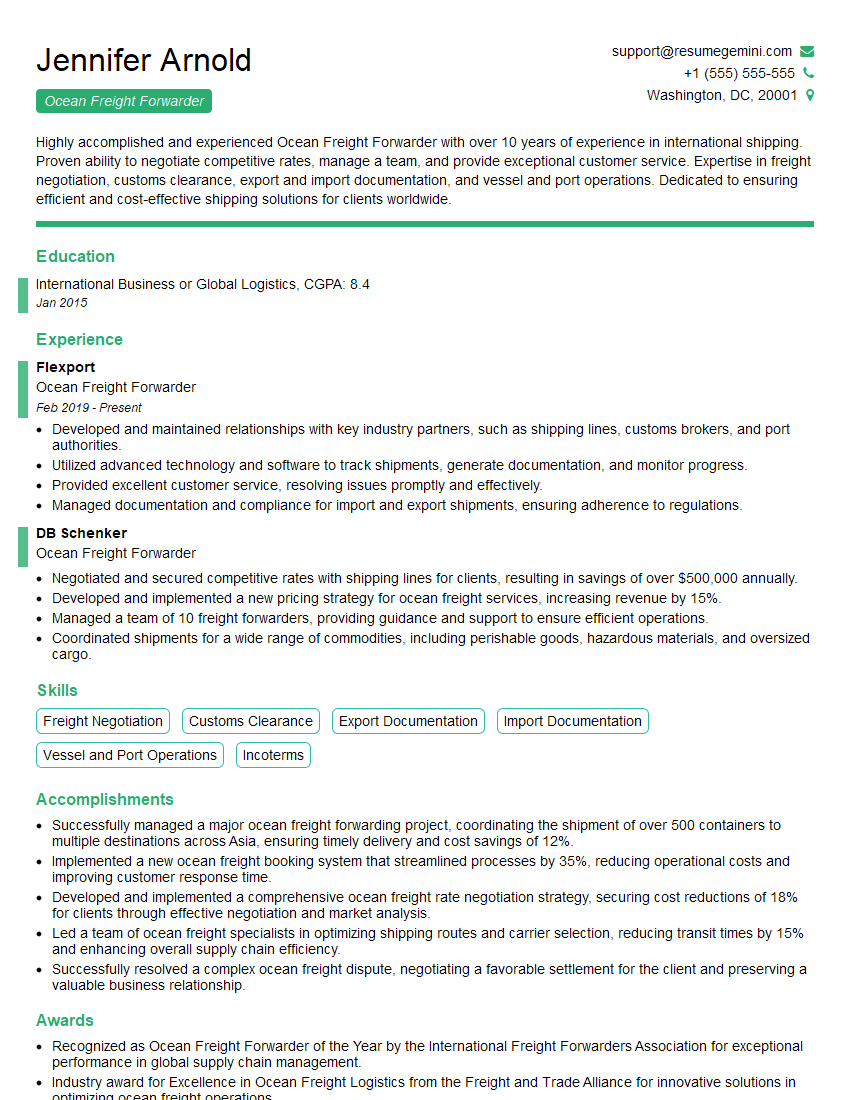Interviews are more than just a Q&A session—they’re a chance to prove your worth. This blog dives into essential Forwarder Operation interview questions and expert tips to help you align your answers with what hiring managers are looking for. Start preparing to shine!
Questions Asked in Forwarder Operation Interview
Q 1. Explain the Incoterms rules and their implications for freight forwarding.
Incoterms, or International Commercial Terms, are a set of standardized trade terms published by the International Chamber of Commerce (ICC). These terms define the responsibilities of buyers and sellers in international trade transactions, specifically regarding delivery and costs. They are crucial for freight forwarding because they clearly delineate who is responsible for various aspects of shipping, such as freight costs, insurance, and risk transfer at different stages of the shipment.
- For example, under CIF (Cost, Insurance, and Freight), the seller is responsible for arranging the shipment, including freight and insurance, up to the named port of destination. The buyer takes over responsibility once the goods reach the port. Conversely, under FOB (Free On Board), the seller’s responsibility ends once the goods are loaded onto the vessel at the named port of shipment. The buyer then assumes responsibility for all subsequent costs and risks.
- Another example, EXW (Ex Works) places the maximum responsibility on the buyer, as the seller only delivers the goods at their premises. The buyer handles everything from there.
Understanding Incoterms is paramount for freight forwarders to accurately quote prices, arrange insurance, and manage documentation, preventing costly disputes between buyers and sellers. Selecting the correct Incoterm is critical to avoid misunderstandings and liability issues.
Q 2. Describe your experience with different modes of transportation (air, sea, land).
My experience spans all major modes of transportation. In air freight, I’ve managed time-sensitive shipments requiring expedited handling and specialized temperature control, such as pharmaceuticals. This involves coordinating with airlines, handling customs documentation for quick clearance, and tracking shipments meticulously to minimize delays. I’ve successfully navigated challenges like flight cancellations and unexpected weather delays.
In sea freight, I’ve handled large-scale container shipments, optimizing routes for cost-effectiveness and transit time, negotiating with shipping lines for favorable rates and space allocation. Experience includes managing complex documentation, including Bills of Lading and other necessary shipping documents, and resolving issues concerning port congestion and potential delays.
Land transport, primarily trucking, has been crucial in managing the last-mile delivery and first-mile pickup of goods for both air and sea freight. I’ve coordinated with trucking companies, optimized routes to avoid traffic and tolls, and ensured timely delivery to final destinations. This includes managing specialized transport requirements, such as oversized or hazardous cargo.
Q 3. How do you handle customs documentation and compliance?
Customs compliance is critical and I have a proven track record of accurate and timely customs documentation. My process includes:
- Accurate data entry: I meticulously gather all required information, including HS codes (Harmonized System codes), country of origin, and value of goods, ensuring complete and accurate data entry to avoid delays and penalties.
- Document preparation: I prepare all necessary documents such as commercial invoices, packing lists, certificates of origin, and any other required documentation specific to the shipment and destination country.
- Compliance checks: I regularly update myself on the latest regulations and compliance requirements for various countries and proactively identify potential risks and mitigate them.
- Brokerage utilization: When required, I collaborate closely with customs brokers to ensure smooth customs clearance, leveraging their expertise for complex shipments or challenging regulatory environments.
- Record keeping: I maintain detailed records of all customs-related documents and communications for auditing purposes and easy retrieval when needed.
I’ve personally handled situations where minor discrepancies in documentation led to significant delays and I’ve developed the expertise to prevent such issues through meticulous attention to detail.
Q 4. What are your strategies for optimizing freight costs?
Optimizing freight costs is a continuous process. My strategies involve:
- Negotiating rates: Building strong relationships with carriers allows me to negotiate favorable rates and contracts, securing better pricing and potentially securing volume discounts.
- Route optimization: Using advanced route planning software and my experience, I identify the most cost-effective routes, considering factors such as distance, fuel costs, transit time, and potential delays.
- Consolidation of shipments: Combining smaller shipments into larger consolidated loads reduces per-unit costs.
- Mode selection: Carefully evaluating the trade-off between speed and cost allows selection of the most appropriate mode of transport (air, sea, or land).
- Container optimization: Efficiently packing containers maximizes space utilization and minimizes the number of containers required, thereby reducing shipping costs.
- Vendor negotiation: Collaborating with suppliers to optimize packaging and reduce overall shipment weight or volume can significantly impact cost.
For example, I recently saved a client 15% on their shipping costs by negotiating a better rate with a carrier and optimizing their container packing strategy.
Q 5. Explain your process for tracking shipments and managing delays.
Shipment tracking and delay management are critical. My process combines proactive monitoring with reactive problem-solving:
- Real-time tracking: I utilize tracking systems to monitor shipments in real-time, getting updates on location, status, and potential delays.
- Proactive communication: Regular communication with clients, carriers, and other stakeholders ensures everyone is informed about the shipment’s progress.
- Contingency planning: I develop contingency plans to address potential delays, such as alternative transportation options or rerouting strategies.
- Root cause analysis: When delays occur, I conduct a thorough root cause analysis to identify the underlying reasons and prevent similar occurrences in the future.
- Escalation procedures: I have clearly defined escalation procedures to handle critical delays and ensure timely resolution.
In one instance, a port strike threatened a significant delay. By proactively communicating with the client and exploring alternative routes, I managed to minimize the impact on delivery time.
Q 6. How do you manage relationships with carriers and suppliers?
Maintaining strong relationships with carriers and suppliers is crucial for success. My approach is based on:
- Regular communication: I maintain regular contact with key personnel to foster trust and collaboration.
- Performance evaluation: I consistently evaluate carrier and supplier performance based on factors such as reliability, cost-effectiveness, and service quality.
- Negotiation and collaboration: I engage in constructive negotiations and collaborate on solutions to mutually beneficial challenges.
- Relationship building: I actively build relationships based on mutual respect, open communication, and trust.
- Fair and timely payments: I ensure timely and accurate payment to maintain a positive and collaborative relationship.
By nurturing strong relationships, I gain access to preferential rates, improved service, and reliable support when facing unexpected challenges.
Q 7. Describe your experience with cargo insurance and claims processing.
Cargo insurance is essential to mitigate risks associated with loss or damage during transit. My experience includes selecting appropriate insurance coverage based on the shipment’s value, nature of goods, and route. I work with reputable insurance providers to secure comprehensive coverage.
When claims arise, my process involves:
- Documentation gathering: I meticulously gather all relevant documentation to support the claim, including invoices, bills of lading, photos of damaged goods, and reports from involved parties.
- Claim submission: I prepare and submit the claim accurately and efficiently, adhering to the insurer’s guidelines.
- Claim follow-up: I diligently follow up on the claim status, ensuring timely processing and resolution.
- Negotiation: I actively negotiate with insurers to secure fair compensation for losses.
I successfully negotiated a full settlement for a client whose shipment was damaged in transit, demonstrating my ability to navigate the complexities of claims processing and secure favorable outcomes.
Q 8. How do you prioritize tasks and manage multiple shipments simultaneously?
Prioritizing tasks and managing multiple shipments simultaneously requires a structured approach. I utilize a combination of tools and methodologies to ensure efficiency and prevent delays. Think of it like conducting an orchestra – each instrument (shipment) needs attention, but the conductor (me) must ensure harmony.
- Prioritization Matrix: I employ a matrix based on factors like delivery deadlines, shipment value, and client priority. Urgent, high-value shipments with tight deadlines naturally take precedence.
- Task Management Software: I’m proficient with tools like Asana or Trello to track shipments, set deadlines, and assign tasks to team members. This ensures transparency and accountability.
- Regular Review and Adjustment: Throughout the day, I review the status of each shipment. Unexpected delays or changes in priorities require agile adjustments to my plan. For instance, if a port experiences congestion, I’ll proactively communicate with the client and explore alternative routes.
- Communication is Key: Keeping clients informed about the progress of their shipments is crucial. Regular updates minimize anxiety and build trust.
For example, I once managed three simultaneous shipments – one high-value, time-sensitive shipment of medical equipment, one large-volume shipment of consumer goods, and one smaller, less urgent shipment. Using my prioritization matrix and task management software, I successfully ensured all shipments were delivered on time and without incident.
Q 9. What software or systems are you familiar with for freight forwarding?
My experience encompasses a wide range of software and systems used in freight forwarding. I’m highly proficient in:
- Transportation Management Systems (TMS): These are the backbone of our operations, allowing for streamlined tracking, documentation, and communication. I’ve worked extensively with systems like SAP TM and Oracle Transportation Management.
- Customs Brokerage Software: I’m well-versed in software used for filing customs declarations and managing import/export processes. This includes systems specifically designed for handling HS Codes and related documentation.
- Cargo Tracking Systems: Real-time tracking platforms are essential. I’m familiar with various systems that provide updates on shipment location, status, and estimated time of arrival (ETA).
- Customer Relationship Management (CRM): Systems like Salesforce allow me to effectively manage client interactions, track communications, and maintain a record of all shipment-related details.
Moreover, I’m comfortable using Microsoft Office Suite (Word, Excel, PowerPoint) for creating reports, presentations, and maintaining accurate records. My proficiency in these systems allows me to seamlessly integrate information and maintain a high level of organization.
Q 10. How do you handle customer inquiries and complaints?
Handling customer inquiries and complaints effectively is paramount. I believe in proactive communication and problem-solving to maintain positive client relationships. My approach is centered on:
- Prompt Response: I always strive to respond to inquiries promptly, acknowledging the client’s concern within a specified timeframe.
- Active Listening: I carefully listen to understand the client’s perspective before offering a solution. Empathy goes a long way in diffusing stressful situations.
- Clear and Concise Communication: I communicate updates and solutions in a clear and straightforward manner, avoiding jargon.
- Problem-Solving: I systematically investigate issues, identify the root cause, and propose effective solutions. This might involve liaising with carriers, customs agents, or other stakeholders.
- Documentation: Thorough documentation of all interactions and resolutions is vital for future reference and transparency.
For example, I once resolved a complaint about a delayed shipment by proactively communicating with the carrier, identifying the cause of the delay (unexpected port congestion), and negotiating a revised delivery schedule, keeping the client updated every step of the way. The client appreciated the transparency and quick resolution.
Q 11. Describe your experience with dangerous goods handling and regulations.
Handling dangerous goods requires meticulous attention to detail and strict adherence to regulations. I have extensive experience in managing the transportation of hazardous materials, complying with international and national regulations like IATA, IMDG, and 49 CFR.
- Documentation: I’m proficient in preparing and reviewing the necessary documentation, including Shipper’s Declarations (e.g., DG declaration), ensuring accuracy and completeness.
- Packaging and Labeling: I understand the specific packaging and labeling requirements for different classes of dangerous goods, ensuring compliance with all relevant regulations.
- Segregation and Stowage: I am knowledgeable about the proper segregation and stowage of dangerous goods to prevent hazardous situations during transport.
- Emergency Response: I am familiar with emergency procedures and have completed relevant training to handle potential incidents during transportation.
For instance, I once successfully handled the transportation of a shipment containing flammable liquids, ensuring strict adherence to all regulations. This involved coordinating with specialized carriers, procuring appropriate packaging, and ensuring all documentation was flawlessly prepared. The shipment was delivered safely and on schedule.
Q 12. How do you ensure the security and integrity of shipments?
Ensuring shipment security and integrity is a top priority. I use a multi-layered approach to safeguard goods from loss, damage, or theft.
- Secure Packaging: Properly packaged goods are less susceptible to damage. This includes using appropriate materials and techniques for different goods.
- Cargo Insurance: Insurance policies protect against loss or damage, providing financial security for both the client and the forwarder.
- Tracking and Monitoring: Real-time tracking provides visibility into the shipment’s journey, allowing for prompt identification and response to potential issues.
- Secure Transportation: Selecting reputable and secure carriers is crucial. This includes carriers with proven security protocols and GPS tracking.
- Customs Compliance: Accurate documentation and compliance with customs regulations minimize the risk of delays, seizures, or other security breaches.
For example, when handling high-value electronics, I prioritize secure packaging, utilize GPS tracking, and ensure shipment through reputable carriers with strong security measures. This proactive approach minimizes risk and ensures the client’s peace of mind.
Q 13. Explain your understanding of freight rate calculations and negotiations.
Freight rate calculations and negotiations are complex but critical aspects of freight forwarding. My understanding encompasses various factors.
- Cost Elements: I understand the various components of freight rates, including fuel surcharges, currency exchange rates, handling fees, and other accessorial charges.
- Rate Negotiation: I’m skilled in negotiating favorable rates with carriers based on volume, route, and service requirements. This involves leveraging my relationships and market knowledge.
- Market Analysis: Staying abreast of market trends and competitor pricing is vital for effective negotiation. I utilize market intelligence tools and industry reports.
- Contract Management: I’m experienced in managing contracts with carriers, ensuring that agreed-upon rates and service levels are maintained.
For example, I once negotiated a significantly lower freight rate for a client by consolidating their shipments, securing a volume discount, and choosing an optimal shipping route. This resulted in considerable cost savings for the client while maintaining the required delivery timeline.
Q 14. What is your experience with different types of shipping documents (e.g., bill of lading, packing list)?
Shipping documents are the cornerstone of successful freight forwarding. My experience covers a wide range of these crucial documents.
- Bill of Lading (B/L): This is the most important document, acting as a contract of carriage between the shipper, carrier, and consignee. It provides details about the shipment, including the goods, destination, and payment terms.
- Packing List: This document lists the contents of each package within the shipment, providing a detailed inventory. It’s crucial for customs clearance and damage claims.
- Commercial Invoice: This invoice provides details about the sale of goods, including the description of goods, quantity, price, and payment terms.
- Certificate of Origin (COO): This document verifies the origin of the goods, which is often required for customs clearance.
- Other Documents: Depending on the shipment and destination, other documents such as import permits, health certificates, and insurance certificates may be required.
I’m adept at preparing, reviewing, and interpreting these documents, ensuring accuracy and completeness to avoid delays and complications throughout the shipping process. For example, I once identified an error in a commercial invoice that could have resulted in significant customs delays. By promptly correcting the error, I prevented a costly and time-consuming issue for the client.
Q 15. How do you handle unexpected events or disruptions in the supply chain?
Handling unexpected supply chain disruptions requires a proactive and multi-faceted approach. Think of it like navigating a storm at sea – you need a plan, backups, and the ability to adapt quickly. My strategy involves several key steps:
- Risk Assessment and Mitigation: Regularly analyzing potential disruptions (e.g., natural disasters, port congestion, geopolitical instability) and developing contingency plans. This could involve diversifying suppliers, securing alternative transportation routes, or building safety stock.
- Real-time Monitoring and Communication: Utilizing technology like GPS tracking and advanced TMS (Transportation Management Systems) to monitor shipments and instantly identify delays or issues. Open communication with all stakeholders (suppliers, carriers, customers) is crucial for collaborative problem-solving.
- Flexible Response Mechanisms: Having the capacity to swiftly adjust plans based on unforeseen events. This might include rerouting shipments, negotiating with carriers for expedited services, or exploring alternative transportation modes (e.g., air freight instead of sea freight).
- Incident Management Protocol: Establishing a clear process for handling disruptions, from initial detection to resolution. This often includes designating a crisis response team, establishing communication channels, and documenting the entire process for future improvement.
For example, during a recent port strike, I successfully mitigated the impact by proactively rerouting shipments through a less congested port, incurring only minimal delays and cost overruns. This involved close collaboration with our shipping partners and keeping our customers informed every step of the way.
Career Expert Tips:
- Ace those interviews! Prepare effectively by reviewing the Top 50 Most Common Interview Questions on ResumeGemini.
- Navigate your job search with confidence! Explore a wide range of Career Tips on ResumeGemini. Learn about common challenges and recommendations to overcome them.
- Craft the perfect resume! Master the Art of Resume Writing with ResumeGemini’s guide. Showcase your unique qualifications and achievements effectively.
- Don’t miss out on holiday savings! Build your dream resume with ResumeGemini’s ATS optimized templates.
Q 16. What is your understanding of import and export regulations?
Understanding import and export regulations is paramount in international freight forwarding. It’s like knowing the rules of the road before embarking on a long journey. My expertise covers a wide range of regulations, including:
- Customs Regulations: This includes tariff classifications, duty calculations, customs declarations (e.g., using the correct HS codes), and compliance with import/export licensing requirements. I’m familiar with the complexities of different countries’ customs procedures and ensure all documentation is accurate and up-to-date.
- Trade Agreements: Knowledge of relevant trade agreements (e.g., NAFTA, EU trade agreements) to take advantage of preferential tariffs or reduce trade barriers.
- Sanctions and Embargoes: Strict adherence to international sanctions and embargoes to ensure compliance with legal restrictions on the movement of goods to or from specific countries or entities.
- Safety and Security Regulations: Compliance with regulations related to the safe transport of hazardous materials (HAZMAT) and security protocols like the Customs-Trade Partnership Against Terrorism (C-TPAT).
I have successfully navigated complex regulatory landscapes, ensuring timely and compliant delivery of goods even when dealing with stringent import/export restrictions. I’m also always up-to-date on regulatory changes through continuous professional development.
Q 17. Describe your experience with warehouse management and logistics.
My experience in warehouse management and logistics encompasses all aspects of inventory control, order fulfillment, and efficient movement of goods. It’s like being an orchestra conductor, ensuring all instruments (processes) work harmoniously. My skills include:
- Inventory Management: Utilizing inventory control systems to track stock levels, manage storage space, and minimize waste. I have experience with both FIFO (First-In, First-Out) and LIFO (Last-In, First-Out) inventory management methods.
- Warehouse Layout and Design: Optimizing warehouse space to maximize efficiency and minimize handling times. This includes strategic placement of goods, efficient workflow design, and the appropriate use of material handling equipment.
- Order Fulfillment: Streamlining the process of picking, packing, and shipping orders to ensure timely and accurate fulfillment. I have experience with various order fulfillment methods, including batch picking and wave picking.
- Warehouse Safety and Security: Implementing procedures to maintain a safe and secure warehouse environment, complying with all relevant safety regulations.
For example, I implemented a new warehouse management system that reduced order processing time by 20% and improved inventory accuracy significantly. This involved careful analysis of existing processes, staff training, and system integration.
Q 18. How do you ensure on-time delivery of shipments?
Ensuring on-time delivery requires meticulous planning, proactive problem-solving, and robust communication. It’s like managing a complex project, each step contributing to the final deadline. My approach involves:
- Accurate Scheduling and Planning: Utilizing advanced TMS to develop realistic delivery schedules, considering all potential factors (transit times, customs clearance, handling times).
- Real-time Tracking and Monitoring: Continuously tracking shipments to identify potential delays and proactively address them. This often involves collaborating with carriers to expedite delivery or find alternative solutions.
- Proactive Communication: Keeping all stakeholders (customers, suppliers, carriers) informed about the shipment status, addressing any concerns promptly.
- Contingency Planning: Having backup plans in place for unforeseen circumstances (e.g., weather delays, unforeseen traffic congestion).
In a recent project, a sudden blizzard threatened to delay a critical shipment. By proactively rerouting the shipment and coordinating with the carrier, we were able to successfully deliver on time, avoiding significant disruptions to our client’s operations.
Q 19. Explain your experience with different types of containers and their suitability.
My experience encompasses a wide range of container types, each suited to specific cargo needs. Choosing the right container is like selecting the right tool for a job. Here are some examples:
- Standard Dry Containers: Suitable for most general cargo, offering cost-effective transportation.
- Refrigerated Containers (Reefer Containers): Essential for temperature-sensitive goods like perishable food products, pharmaceuticals, and chemicals.
- Open-Top Containers: Ideal for oversized or heavy cargo that needs to be loaded from above.
- Flatrack Containers: Designed for extremely heavy or oversized cargo that requires specialized loading and unloading equipment.
- Tank Containers: Used for transporting liquid goods in bulk.
Selecting the right container type requires careful consideration of the cargo’s characteristics (size, weight, temperature sensitivity, hazardous nature) and the transportation route. For example, I recently helped a client transport oversized machinery using flatrack containers, ensuring efficient and safe transport.
Q 20. How do you address discrepancies between documentation and actual shipments?
Addressing discrepancies between documentation and actual shipments requires a methodical and thorough approach. It’s like forensic accounting, meticulously investigating to find the truth. My process involves:
- Thorough Verification: Carefully comparing shipping documents (packing lists, commercial invoices, bills of lading) with the actual contents of the shipment.
- Physical Inspection: Conducting a physical inspection of the shipment whenever discrepancies are identified. This could involve opening containers to verify the contents.
- Investigation and Root Cause Analysis: Investigating the cause of the discrepancy. This often involves reviewing warehouse procedures, shipping documentation, and communication records.
- Corrective Actions: Taking corrective actions to prevent similar discrepancies from occurring in the future. This could involve updating procedures, providing additional training, or implementing new quality control measures.
- Communication with Stakeholders: Keeping all stakeholders informed throughout the process, providing clear explanations and solutions.
In one instance, I discovered a discrepancy in the number of pallets shipped versus what was indicated on the documentation. Through thorough investigation, I found a labeling error at the warehouse. This led to a review of our warehouse procedures and implementation of a new double-checking system.
Q 21. What is your proficiency in using transportation management systems (TMS)?
I’m highly proficient in utilizing Transportation Management Systems (TMS). Think of it as a powerful cockpit for managing all aspects of transportation. My expertise encompasses:
- Shipment Planning and Execution: Using TMS to plan routes, optimize delivery schedules, and track shipments in real-time.
- Carrier Management: Managing relationships with carriers, negotiating rates, and tracking carrier performance.
- Document Management: Generating and managing shipping documents (bills of lading, packing lists, etc.) electronically, streamlining the process.
- Reporting and Analytics: Utilizing TMS reporting features to monitor key performance indicators (KPIs) like on-time delivery rates, transportation costs, and overall efficiency.
- Integration with Other Systems: Integrating TMS with other enterprise systems like ERP (Enterprise Resource Planning) and WMS (Warehouse Management System) for seamless data flow.
I have extensive experience with various TMS platforms, including Oracle Transportation Management and SAP Transportation Management. I have successfully implemented TMS solutions for clients resulting in significant cost savings and operational improvements.
Q 22. Describe your experience with capacity planning and resource allocation.
Capacity planning and resource allocation in freight forwarding are crucial for optimizing operations and minimizing costs. It involves forecasting future demand, assessing available resources (equipment, personnel, warehousing space), and strategically allocating them to meet projected needs. This isn’t just about numbers; it’s about anticipating peaks and troughs in demand and ensuring we’re neither overspending on idle resources nor underprepared for surges.
In my previous role, we used a combination of historical data analysis, market trend forecasting, and predictive modeling to estimate shipment volumes for the next quarter. This allowed us to negotiate favorable rates with carriers for container space during peak seasons and optimize warehouse space utilization. For example, we noticed a consistent spike in shipments during the holiday season. By predicting this accurately, we secured additional warehousing capacity in advance, avoiding costly last-minute arrangements and ensuring timely delivery. We also implemented a robust system for tracking equipment utilization, allowing us to identify underutilized assets and redistribute them efficiently. This involved using a dedicated software which provided real-time updates of container locations and availability.
Q 23. How do you measure the efficiency and effectiveness of your operations?
Measuring efficiency and effectiveness in freight forwarding involves a multi-faceted approach focusing on key performance indicators (KPIs). We track metrics such as on-time delivery rates, shipment processing time, cost per shipment, customer satisfaction scores, and cargo damage rates. These KPIs provide a comprehensive overview of operational performance, highlighting areas for improvement.
For instance, a consistently low on-time delivery rate might indicate issues with carrier selection, customs clearance processes, or internal handling procedures. Analyzing cost per shipment can reveal areas of inefficiency, such as excessive warehousing fees or inefficient routing. Customer feedback surveys help us gauge satisfaction and identify areas needing improvement in customer service. We use data visualization tools to track these KPIs over time, allowing us to identify trends and make data-driven decisions.
Q 24. Explain your understanding of supply chain risk management.
Supply chain risk management in freight forwarding is paramount. It involves identifying, assessing, and mitigating potential disruptions that could affect the timely and cost-effective delivery of goods. These risks can range from geopolitical instability and natural disasters to port congestion, carrier bankruptcy, and even pandemics. A proactive approach is essential.
My strategy involves developing contingency plans for various scenarios. For example, having alternative carriers lined up in case of disruptions, maintaining diverse sourcing options to mitigate supplier risk, and building strong relationships with customs brokers to expedite clearance processes. We also utilize advanced analytics to monitor global events and their potential impact on our operations, and we regularly review our risk assessment to adapt to evolving circumstances. Imagine the impact of a major port strike – having alternative routes and carriers in place could be the difference between meeting deadlines and significant losses.
Q 25. How do you maintain accurate records and documentation?
Maintaining accurate records and documentation is fundamental in freight forwarding, ensuring compliance, facilitating audits, and enabling efficient tracking of shipments. We utilize a Transportation Management System (TMS) that integrates all aspects of our operations, from booking and documentation to tracking and reporting. This system ensures a centralized, auditable trail of every shipment.
Every document, from bills of lading and commercial invoices to customs declarations and insurance certificates, is electronically stored and readily accessible. Our procedures emphasize data validation and regular data backups to prevent data loss and maintain integrity. We also adhere to strict data governance policies, ensuring the confidentiality and security of sensitive information.
Q 26. Describe your experience with auditing and compliance procedures.
Auditing and compliance are critical aspects of freight forwarding, ensuring adherence to regulations and maintaining ethical business practices. We undergo regular internal audits to evaluate our compliance with relevant laws and regulations, such as customs regulations, safety standards, and data protection laws. We also cooperate fully with external audits conducted by clients and regulatory bodies.
My experience includes preparing and presenting audit reports, implementing corrective actions based on audit findings, and maintaining comprehensive documentation to support our compliance efforts. We stay updated on changes in regulations and best practices to ensure ongoing compliance. A robust compliance program not only protects the business from penalties but also builds trust with clients and stakeholders.
Q 27. What are your strategies for continuous improvement in freight forwarding operations?
Continuous improvement in freight forwarding requires a proactive and data-driven approach. We use a combination of strategies including Lean methodologies, Six Sigma principles, and regular performance reviews to identify areas for optimization. This involves analyzing our KPIs, identifying bottlenecks, and implementing process improvements to enhance efficiency and effectiveness.
For example, using Lean principles, we mapped our shipment processing workflow, identified redundancies, and streamlined the process, reducing processing time by 15%. Implementing Six Sigma methodologies helped us reduce cargo damage rates significantly by focusing on root cause analysis and process standardization. Regular training and upskilling of our personnel ensures they are equipped with the latest industry knowledge and best practices. Continuous improvement is a journey, not a destination, and it requires a commitment to ongoing learning and adaptation.
Key Topics to Learn for Forwarder Operation Interview
- Incoterms: Understanding and applying various Incoterms (e.g., FOB, CIF, DDP) to determine responsibilities and liabilities throughout the shipping process. Practical application includes correctly interpreting contracts and anticipating potential issues based on chosen Incoterms.
- Freight Documentation: Mastering the creation and management of essential shipping documents such as Bills of Lading (B/L), packing lists, commercial invoices, and certificates of origin. Practical application involves understanding the implications of errors and delays in documentation.
- Shipping Modes & Logistics: Gaining a comprehensive understanding of different transportation modes (sea, air, rail, road) and their respective advantages and disadvantages. Practical application includes selecting the optimal mode based on factors like cost, speed, and cargo type.
- Cargo Handling & Security: Knowledge of proper cargo handling procedures to minimize damage and loss during transit. Understanding security protocols and regulations to ensure compliance and protect shipments. Practical application involves risk assessment and mitigation strategies.
- Customs & Regulations: Familiarity with customs procedures, import/export regulations, and documentation requirements for various countries. Practical application includes navigating complex regulations and ensuring timely and compliant clearance of goods.
- Rate Negotiation & Cost Management: Skills in negotiating favorable freight rates with carriers and managing operational costs effectively. Practical application involves understanding market dynamics and utilizing different strategies to optimize costs.
- Tracking & Tracing: Proficiency in utilizing tracking systems to monitor shipment progress and address potential delays or issues proactively. Practical application involves problem-solving and effective communication with stakeholders.
- Supply Chain Management Principles: Understanding the broader context of forwarder operations within the global supply chain. Practical application includes identifying bottlenecks and proposing solutions to improve efficiency and reduce lead times.
Next Steps
Mastering Forwarder Operation opens doors to exciting career advancements, offering opportunities for specialization, increased responsibility, and higher earning potential. To maximize your job prospects, creating an ATS-friendly resume is crucial. ResumeGemini is a trusted resource to help you build a professional and impactful resume that highlights your skills and experience effectively. Examples of resumes tailored to Forwarder Operation are available to guide you, ensuring your application stands out from the competition.
Explore more articles
Users Rating of Our Blogs
Share Your Experience
We value your feedback! Please rate our content and share your thoughts (optional).
What Readers Say About Our Blog
Hello,
We found issues with your domain’s email setup that may be sending your messages to spam or blocking them completely. InboxShield Mini shows you how to fix it in minutes — no tech skills required.
Scan your domain now for details: https://inboxshield-mini.com/
— Adam @ InboxShield Mini
Reply STOP to unsubscribe
Hi, are you owner of interviewgemini.com? What if I told you I could help you find extra time in your schedule, reconnect with leads you didn’t even realize you missed, and bring in more “I want to work with you” conversations, without increasing your ad spend or hiring a full-time employee?
All with a flexible, budget-friendly service that could easily pay for itself. Sounds good?
Would it be nice to jump on a quick 10-minute call so I can show you exactly how we make this work?
Best,
Hapei
Marketing Director
Hey, I know you’re the owner of interviewgemini.com. I’ll be quick.
Fundraising for your business is tough and time-consuming. We make it easier by guaranteeing two private investor meetings each month, for six months. No demos, no pitch events – just direct introductions to active investors matched to your startup.
If youR17;re raising, this could help you build real momentum. Want me to send more info?
Hi, I represent an SEO company that specialises in getting you AI citations and higher rankings on Google. I’d like to offer you a 100% free SEO audit for your website. Would you be interested?
Hi, I represent an SEO company that specialises in getting you AI citations and higher rankings on Google. I’d like to offer you a 100% free SEO audit for your website. Would you be interested?
good
